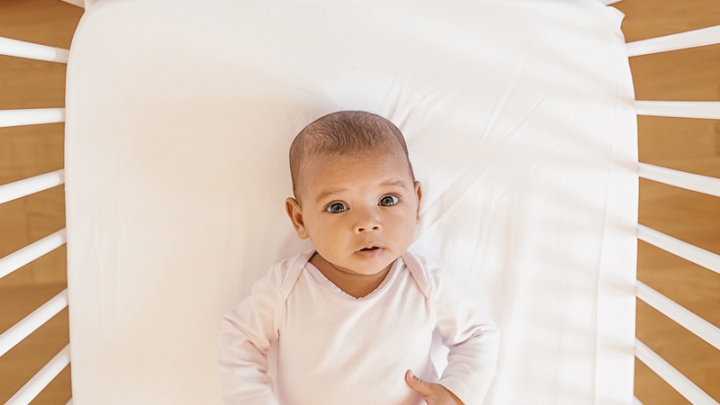Here's how to help prevent sudden infant death syndrome (SIDS).
SIDS is an unexplained death of an otherwise healthy baby younger than 1 that occurs typically during sleep.
A type of sudden unexpected infant deaths (SUID), SIDS is the leading cause of death in infants 1 to 12 months old, according to the Centers for Disease Control and Prevention (CDC).
Although there is not a guaranteed method to prevent SIDS, creating a safe sleep environment for your baby through these steps may make all the difference.
Establish a Safe Sleep Environment
The safest place for your baby to sleep is in a safe crib or bassinet. Avoid placing the crib or bassinet near a window, as the blind cords can pose a strangulation hazard. Furthermore, avoid placing other items that have cords near the crib.
The CDC recommends checking the crib for loose or missing parts. A crib with missing hardware can result in the side rail moving positions, potentially causing your baby to become stuck between the rail and the mattress.
Be aware of whether the crib you have purchased has had any product recalls. If your crib needs any repairs, make sure to use the parts the manufacturer provides.
Safety Tips
1) Always place your baby on his or her back. Never place your baby on his or her side, as this is not a stable position. Your baby can easily turn onto his or her stomach.
2) Keep the crib bare and remove all pillows, extra bedding and plush toys. Avoid laying your baby on thick or fluffy quilts. The mattress should be firm. In fact, experts recommend removing all extra bedding, pillows and plush toys. Crib bumpers and infant sleep positioners are not recommended.
3) Let your baby sleep alone.As much as you may want to sleep with your baby, having your baby sleep in your bed is not safe and is therefore not recommended. Your baby can become caught and suffocate in different areas on an adult mattress.
4) Check the space between the crib and mattress. The mattress should fit tightly within the crib. In fact, there should not be any big gaps. Check the space between the mattress and crib. If you can fit two fingers in between the mattress and the crib, it is not a safe sleeping condition. Your baby can become stuck in the gap.
Baby monitors and other commercial devices that claim to reduce the risk of SIDS
A variety of baby products are marketed to prevent or reduce the risk of SIDS. According to the US Food and Drug Administration (FDA), some examples of these baby products include the following:
- Baby monitors
- Mattresses
- Crib tents
- Pillows
- Crib bedding, including bumpers and blankets
- Infant positioners
None of these baby products have been approved by the FDA to prevent or reduce the risk of SIDS. In fact, the FDA has never approved a product to prevent or reduce the risk of SIDS.
If you have any questions about preventing SIDS, ask your pediatrician.




